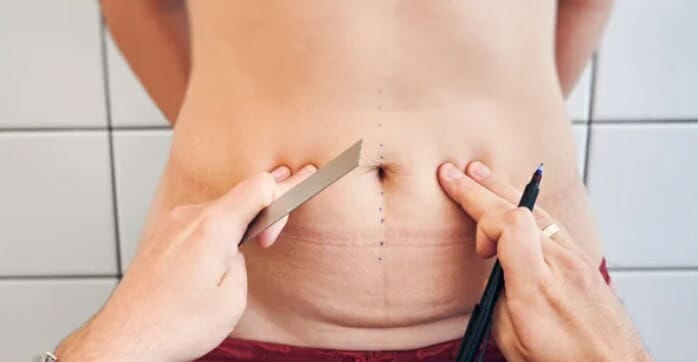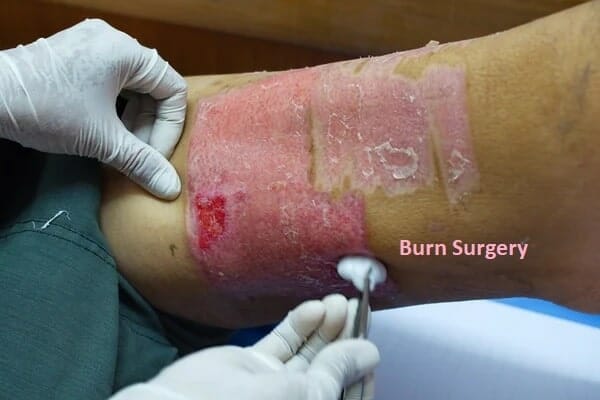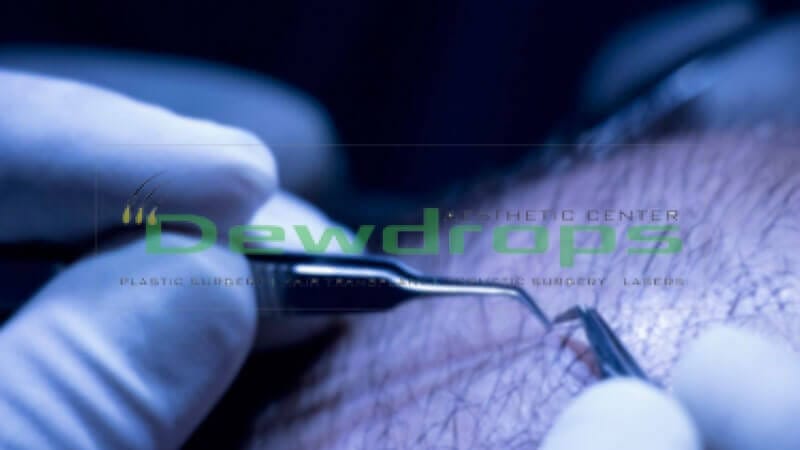
In both boys and men, Gynecomastia is a common condition. A distinct condition called pseudogynecomastia causes breast fat to accumulate, possibly as a result of being overweight or obese. Dr Susant Mishra is one of the top Gynecomastia surgeons in Bhubaneswar, Odisha, who has MCh. Degree in Burns, Plastic & Reconstructive surgery. Consult today if any patient needs gynecomastia surgery in Bhubaneswar, Odisha. 100% successful surgery with the best care.
What is Gynecomastia?
Gynecomastia is a condition that causes men to have enlarged or overdeveloped breasts at any age. The disorder may be brought on by hereditary factors, hormonal changes, obesity, or the use of specific drugs. It causes the breasts to enlarge abnormally. Breast glands are present in both men and women, but they are typically not visible in men. Males of any age may develop enlarged breast glands, including newborns, adolescents, and older adults. Rather than extra fat, Gynecomastia is caused by extra breast tissue. Gynecomastia breast tissue does not disappear with exercise or weight loss.
Gynecomastia is distinguished by:
- Excessive localized fat
- Development of glandular tissue in excess
- A surplus of breast skin occasionally
- Either bilaterally (both breasts) or unilaterally (one breast)
Types of Gynecomastia
There are different types of gynecomastia – including benign breast enlargement, idiopathic gynecomastia, and cancerous breast enlargement.
-
Benign Breast Enlargement
Benign breast enlargement is a non-cancerous condition where the size of the breasts increases due to increased fat cells. It is not associated with any underlying disease and does not require treatment. However, if the patient is concerned about their appearance, they may opt for cosmetic surgery.
It is believed to be caused by increased levels of estrogen and testosterone in men. In some cases, breast enlargement may be associated with obesity or alcoholism.
-
Idiopathic Gynecomastia
Idiopathic gynecomastia is a condition where no cause is known. It is characterized by enlarged breasts without any other symptoms. It is generally seen in young adults between the ages 20 and 30.
-
Cancerous Breast Enlargement
Cancerous breast enlargement is a condition where the breasts become larger than normal due to the abnormal growth of cells. It is often accompanied by pain, swelling, redness, and skin irritation. If left untreated, it can lead to ulcers and infections. Malignant gynecomastia occurs when cancerous cells start developing in the breast tissue. Surgery is the only way to remove these tumors.
Causes of Gynecomastia
Gynecomastia is caused by a variety of factors.
An imbalance of the sex hormones estrogen and testosterone may cause gynecomastia. Breast tissue grows when estrogen is present, but testosterone inhibits this growth. In this medical condition, male breasts develop due to hormonal imbalance. It is caused by excessive estrogen levels in men.
Idiopathic Gynecomastia refers to Gynecomastia that has no apparent cause in the majority of cases. But there are some things that can make Gynecomastia more likely. It is typically caused by a rise in the ratio of estrogens, a female hormone, to testosterone, a male hormone. While estrogen, the “female” hormone, causes breast tissue to grow, testosterone, the “male” hormone, inhibits estrogen’s growth in breast tissue by acting as a growth inhibitor.
According to their degree of severity, these are the four types of clinical Gynecomastia:
- Grade 1: Minimal enlargement, but no chest skin overhanging.
- Grade 2: Moderate enlargement, without extra skin on the chest.
- Grade 3 moderate enlargement with extra skin on the chest.
- Grade 4 enlargement with visible extra skin on the chest.
In men who are getting older, breast swelling can recur. Since older men have higher body fat percentages than younger men and less testosterone production, estrogen levels may rise.
Some males may develop the condition as a result of using drugs or herbal remedies like:
- Anabolizing steroids.
- Ulcer-treating drugs.
- Tricyclic antidepressants.
- Medications for treating anxiety, such as diazepam.
- Efavirenz, which is one of a few HIV medications.
- Anti-androgens.
- Calcium channel blockers, which are some medications used to treat heart disease.
Symptoms and Signs of Gynecomastia
In the majority of cases, Gynecomastia is not a serious issue. Gynecomastia can make you feel uncomfortable emotionally and lower your self-esteem. In order to conceal their condition, some men may even avoid specific physical interactions and intimate situations.
The breast gland tissue of one or both breasts may swell and become tender as symptom. It may begin as a lump or fatty tissue near the nipples of the person. The lumps typically form unevenly.
People should see a doctor if there is unusual or persistent pain, nipple discharge, swelling, or a combination of these.
Gynecomastia Diagnosis
A patient’s symptoms, medical and drug history, and possibly family history will all be brought up during a visit to the doctor. The abdomen and genitalia may also be physically examined in addition to the breast tissue.
The doctor might advise against treatment if the condition is thought to be caused by a hormone imbalance and should go away on its own.
A biopsy or blood test may be requested by the doctor if the lump is unusually large, tender, or one-sided in order to exclude breast cancer.
Additional examinations will aim to rule out alternative causes like:
- Cyst
- A furuncle or abscess.
- Lipoma or hamartoma, a benign tumor.
- Mastitis is an infection of the breast tissue.
- Hematoma is the medical term for a solid blood clot.
- Metastasis, cancer that has spread from elsewhere in the body.
- A lump is caused by the destruction of fatty breast tissue, also known as fat necrosis.
Additionally, a physician may request imaging exams such as:
- Ultrasound or mammography of the breast.
- Chest X-rays.
- MRI exams.
- Sonograms of the testicles.
Options for Gynecomastia Treatment
Gynecomastia usually disappears on its own between 6 months and 2-3 years. However, a condition that is underlying might require treatment. There are several treatments for Gynecomastia depending on the type of gynecomastia. These include medications, lifestyle changes, and surgical procedures. Medications are commonly prescribed to reduce the number of hormones produced by the body. Lifestyle changes involve reducing alcohol consumption and smoking. Surgical options include liposuction, breast reduction, and breast augmentation.
Although it is uncommon, treatment options include hormone therapy to block estrogen or breast reduction surgery.
Prescription drugs to treat Gynecomastia
Tamoxifen is a medication that prevents the body’s use of the female hormone estrogen. Although it is frequently used to treat breast cancer, it can also help men who experience breast pain and breast enlargement symptoms.
Aromatase inhibitors can be used to treat or prevent Gynecomastia in post-menopausal patients who have breast or ovarian cancer, which is a common side effect of these medications.
For older males with low testosterone levels, testosterone replacement therapy can help with gynecomastia.
Surgery
Both softer fatty tissue and firm, dense glandular tissue makes up the breast.
Individual differences exist in the proportion of glandular to fatty tissue in the breasts. A man with Gynecomastia might have an excess of both tissues.
Excess fatty tissue can be removed with liposuction. It entails making a small incision and inserting a tube. Excision is the surgical removal of extra glandular tissue by excising tissue with a scalpel. A scar around the nipple’s edge will typically result from this.
The incision and scar will be wider if there needs to be a significant reduction in tissue and skin.
The person may need to wear an elastic pressure garment to reduce swelling after surgery because the chest will be bruised and swollen.
People typically need six weeks to get back to their regular routines. Surgery-related complications are uncommon. Insufficient removal of breast tissue, an uneven chest contour, and diminished nipple sensation are a few of them.
A blood clot could form after excision and might need to be drained.
Types of Gynecomastia Surgeries, Bhubaneswar
Gynecomastia can be so severe that the weight of the extra breast tissue can stretch the areola (the dark skin around the nipple) and cause the breasts to droop. Surgery can be used in these cases to increase the size and position of the areola as well as remove any extra skin. By reducing the size of the male breasts, Gynecomastia surgery flattens and improves the chest contours. Reduction mammaplasty is the medical term for plastic surgery that is performed to treat gynecomastia.
There are many different types of gynecomastia surgeries. Your doctor will determine what kind of surgery is best for you based on your situation. Various types of surgeries are used as a remedy for this medical problem:
-
Breast reduction surgery
Breast reduction surgery is performed to reduce the size of the breasts. It is done to improve the appearance of the patient’s body. A small incision is made at the top of the breast and the excess fat and glandular tissue is removed. Afterwards, the remaining breast tissue is sutured together.
-
Liposuction
Liposuction is a surgical procedure to remove fatty deposits from specific parts of the body. It is commonly used to treat patients who have excessive amounts of fat around their waistline, hips, thighs, buttocks, neck, arms, chin, knees, ankles, calves, and feet. Liposuction is also known as lipoplasty, suction lipectomy, or simply “suctioning.”Liposuction involves removing fat cells from specific areas of the body. It is a safe way to remove fat without damaging surrounding tissue.
-
Male breast reduction surgery
Male breast reduction surgery is done to reduce the size of male breasts. It is done for cosmetic purposes. The procedure involves removing extra breast tissue and reshaping the chest area.Also called male mastectomy, this type of plastic surgery removes the male breast tissue. It is performed to reduce the amount of breast tissue in males.
-
Nipple-sparing mastectomy
Nipple-sparing mastectomy is a type of plastic surgery that reduces the size of the male breast. It is performed to remove excess breast tissue while preserving the nipples.
-
Laser
Another option is to use a laser to destroy the fatty tissue.
-
Saline Solution
One more method is to inject saline solution under the skin to make it swell and then pull out the extra tissue.
Gynecomastia versus Fat
Breast tissue enlargement is a symptom of Gynecomastia. Hormonal changes that encourage the growth of breast tissue may be the cause. Gynecomastia has nothing to do with obesity and neither does it contribute to the buildup of body fat.
An obese or overweight person will have fat all over their body. Men may develop enlarged breasts as a result of this. But unlike gynecomastia, where tissue grows, this enlargement is brought on by fat.
Outlook of Gynecomastia
Gynecomastia cases typically go away on their own, without the need for treatment. The symptoms in newborns and young boys may gradually get better and then go away.
People might need treatment in some circumstances. This might entail surgery or liposuction. The treatments are typically risk-free and unconnected to long-term health risks.
After your surgery, you will need to wear compression garments to help reduce swelling. These garments are worn 24 hours a day until the swelling goes down. You will also need to avoid strenuous activity for at least two weeks.
Most patients report of feeling much better after their surgery. However, you may experience minor side effects including bruising, soreness, and swelling around the incision site. These symptoms go away over time.
FAQ on Gynecomastia
-
What if the medication causes Gynecomastia?
If a medication is the cause of the condition, changing to a different medication may be necessary. The condition will only last a short while if the person takes the medication as prescribed.
-
Is Gynecomastia becoming more prevalent in India?
Gynecomastia patients are becoming more prevalent in India as a result of rising obesity rates, increased anabolic steroid use, and environmental contamination with estrogen-like substances.
-
Who is more prone to Gynecomastia?
Both men and women have the hormones testosterone and estrogen, but men typically have higher levels of testosterone and women have higher levels of estrogen. Newborns and young boys are more susceptible to Gynecomastia due to hormonal changes during development. Nevertheless, it usually resolves itself.
Conclusion
Due to enlarged or overdeveloped breast tissue, Gynecomastia causes one or both breasts to grow in size in males. The condition might result from taking specific medications or from hormonal changes. Typically, symptoms go away on their own. Gynecomastia can be treated with procedures like liposuction. But for the vast majority of people, they are usually unnecessary.
For the best results with Gynecomastia surgery, choose the Dewdrops Aesthetic Center, where surgical treatment for the condition is carried out under the guidance of Dr. Susant Mishra who has MCh. Degree in Burns, Plastic & Reconstructive surgery. You can expect the best outcome for your condition.











